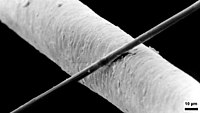
Effect of pH Condition on Natural Indigo (Indigofera tinctoria) Reduction by Yeast (Saccharomyces cerevisiae)
Sign Up to like & getrecommendations! Published in 2019 at "Fibers and Polymers"
DOI: 10.1007/s12221-019-9214-3
Abstract: Ultimate goal of this research is to develop an efficient microbial system for indigo reduction by using yeast (Saccharomyces cerevisiae). For this purpose, we investigated the effect of pH condition on natural indigo (Indigofera tinctoria)… read more here.
Keywords: reduction; condition; reducing power; indigo ... See more keywords

Bio-electro oxidation of indigo carmine by using microporous activated carbon fiber felt as anode and bioreactor support.
Sign Up to like & getrecommendations! Published in 2017 at "Chemosphere"
DOI: 10.1016/j.chemosphere.2017.08.033
Abstract: The bioremediation and electro-oxidation (EO) processes are included among the most promising cleaning and decontamination mechanisms of water. The efficiency of bioremediation is dictated by the biological actuator for a specific substrate, its suitable immobilization… read more here.
Keywords: electro oxidation; carbon fiber; indigo carmine; microporous activated ... See more keywords

Production of indigo through the use of a dual-function substrate and a bifunctional fusion enzyme.
Sign Up to like & getrecommendations! Published in 2020 at "Enzyme and microbial technology"
DOI: 10.1016/j.enzmictec.2020.109692
Abstract: The current chemical process for industrial indigo production puts a heavy burden on the environment. An attractive option would be to develop an alternative biotechnological process which does not rely on a petrochemical. This study… read more here.
Keywords: production; trp; indigo; fmo ... See more keywords

Improvement of the Battery Performance of Indigo, an Organic Electrode Material, Using PEDOT/PSS with d-Sorbitol
Sign Up to like & getrecommendations! Published in 2020 at "ACS Omega"
DOI: 10.1021/acsomega.0c00313
Abstract: Rare-metal-free and high-performance secondary batteries are necessary for improving the efficiency of renewable energy systems. Organic compounds are attractive candidates for the active material of such batteries. Many studies have reported organic active materials that… read more here.
Keywords: electrode; pedot pss; material; active material ... See more keywords

Practical and environment-friendly indirect electrochemical reduction of indigo and dyeing
Sign Up to like & getrecommendations! Published in 2020 at "Scientific Reports"
DOI: 10.1038/s41598-020-61795-5
Abstract: Indigo has been widely used as a dye in the industrial dyeing due to its good color fastness in dyeing cellulose fibers. However, excess reducing agent, “insurance powder (Na 2 S 2 O 4 )”,… read more here.
Keywords: reduction; environment friendly; indigo; indirect electrochemical ... See more keywords

A structurally characterised redox pair involving an indigo radical: indigo based redox activity in complexes with one or two [Ru(bpy)2] fragments.
Sign Up to like & getrecommendations! Published in 2017 at "Dalton transactions"
DOI: 10.1039/c7dt00055c
Abstract: The reaction between indigo, H2Ind, and {Ru(bpy)2(EtOH)2}2+ in EtOH/NaOH produced the compounds [Ru(bpy)2(HInd)]ClO4 [1]ClO4, rac-{[Ru(bpy)2]2(μ-Ind)}(ClO4)2 [2](ClO4)2, and meso-{[Ru(bpy)2]2(μ-Ind)}(ClO4)3 [2](ClO4)3, which were structurally characterised, the latter as the first stable, isolable radical complex of indigo. The… read more here.
Keywords: ind; redox pair; bpy; structurally characterised ... See more keywords

Green and efficient biosynthesis of indigo from indole by engineered myoglobins
Sign Up to like & getrecommendations! Published in 2018 at "RSC Advances"
DOI: 10.1039/c8ra07825d
Abstract: With the demand nowadays for blue dyes, it is of practical importance to develop a green and efficient biocatalyst for the production of indigo. The design of artificial enzymes has been shown to be attractive… read more here.
Keywords: efficient biosynthesis; biosynthesis indigo; indigo; indole ... See more keywords

Electronic and structural properties of the natural dyes curcumin, bixin and indigo
Sign Up to like & getrecommendations! Published in 2021 at "RSC Advances"
DOI: 10.1039/d0ra08474c
Abstract: An optical, electronic and structural characterisation of three natural dyes potentially interesting for application in organic solar cells, curcumin (C21H20O6), bixin (C25H30O4) and indigo (C16H10N2O2), was performed. read more here.
Keywords: natural dyes; bixin; properties natural; indigo ... See more keywords

Environment-friendly nanocellulose-indigo dyeing of textiles
Sign Up to like & getrecommendations! Published in 2021 at "Green Chemistry"
DOI: 10.1039/d1gc02043a
Abstract: Nanofibrillated cellulose technology in combination with chitosan additives provides a sustainable and environmentally sound technology for indigo dyeing of cotton fabrics. read more here.
Keywords: nanocellulose indigo; friendly nanocellulose; environment friendly; dyeing textiles ... See more keywords

Fermentation Blues: Analyzing the Microbiota of Traditional Indigo Vat Dyeing in Hunan, China
Sign Up to like & getrecommendations! Published in 2022 at "Microbiology Spectrum"
DOI: 10.1128/spectrum.01663-22
Abstract: Chemical reducing agents included in modern indigo dyeing to initiate indigo reduction can be harmful to both human health and the environment. Given that traditional indigo dyeing involves natural fermentation in a dye vat using… read more here.
Keywords: indigo reduction; traditional indigo; indigo; fermentation ... See more keywords

Production of Indigo by Recombinant Escherichia coli with Expression of Monooxygenase, Tryptophanase, and Molecular Chaperone
Sign Up to like & getrecommendations! Published in 2022 at "Foods"
DOI: 10.3390/foods11142117
Abstract: Indigo is an important pigment widely used in industries of food, cosmetics, and textile. In this work, the styrene monooxygenase StyAB from Pseudomonas putida was co-expressed with the tryptophanase TnaA and the chaperone groES-groEL in… read more here.
Keywords: escherichia coli; indigo; tryptophanase; expression ... See more keywords